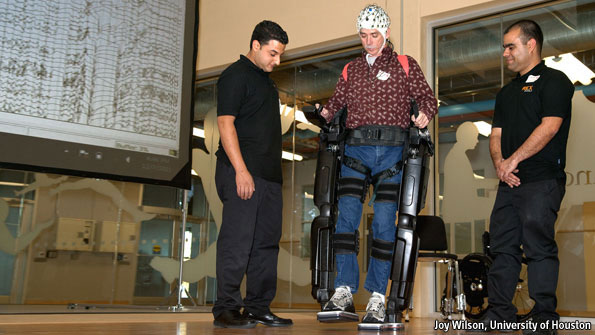A mind to walk again
May 18, 2012 | Source: The Economist
Dr. José Contreras-Vidal of the University of Houston has designed a pair of bionic legs that respond directly to signals from the brain.
The problem with the current brain-computer interface approach — implanting electrodes into a brain, as in the BrainGate2 system, is that it’s a dangerous procedure and can also lead to infections. It also requires a bulky hardware system.
Contreras-Vidal’s approach gets round these difficulties by employing electroencephalography (EEG), which measures those electrical signals from the brain that reach the scalp. The recording electrodes can be carried by a skull cap, and nothing has to penetrate the skin.
Such second-hand signals are not as precise as ones collected directly from the brain itself, and probably could not control the complex movements required of an arm and a hand, but he and colleagues at the University of Maryland were able to do this by analyzing what goes on in the brain when someone moves his limbs.
They used a system of cameras to record the movement patterns of a set of able-bodied volunteers who were walking on a treadmill, and then correlated the result with the electrical signals detected simultaneously at their scalps.
Even a simple task, like wiggling a toe, engages many parts of the brain. These include the frontal cortex (where decisions are made), the motor cortex (which controls muscle activity), the somatosensory cortex (where the sense of touch is located) and the part of the parietal cortex that regulates kinaesthesia (the sense of bodily motion, which is built up from signals from the muscles and the vestibular systems of the ears). By choosing sites carefully, the researchers were able to cover all these areas with as few as 12 electrodes.
The next step is to turn the result into reliable instructions that can operate a set of legs. These are made by Rex Bionics, a firm based in New Zealand. They are a partial exoskeleton that allows a user to stand and walk independently, without crutches, and are normally operated by hand controls. To adapt them to thought control, a group of able-bodied people will first don the cap and perambulate in the legs around a laboratory, to refine the process. Then — with luck, some time this summer — a full-scale trial in collaboration with a group of paralysed volunteers will start.
If the trial works, Dr Contreras-Vidal and his colleagues believe their technique will transform the lives of those with spinal injuries. It might also act as a form of physiotherapy, to help victims of strokes restore the use of their legs.
And it will certainly save a lot of money. A set of bionic legs can cost as much as $150,000. But the lifetime cost of caring for a 25-year-old with severe spinal injury is around $3m.
